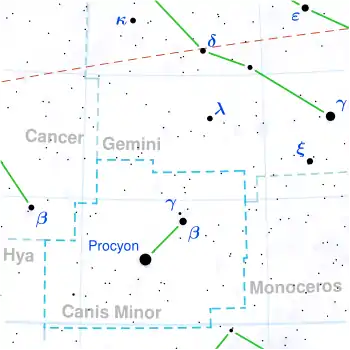Delta2 Canis Minoris
Delta2 Canis Minoris (δ2 CMi, δ2 Canis Minoris) is a main-sequence star in the constellation Canis Minor, about 141 ly away.
 | |
| Observation data Epoch J2000 Equinox J2000 | |
|---|---|
| Constellation | Canis Minor |
| Right ascension | 07h 33m 11.66576s[1] |
| Declination | +03° 17′ 25.3551″[1] |
| Apparent magnitude (V) | 5.589[2] |
| Characteristics | |
| Spectral type | F2 V[3] |
| U−B color index | +0.10[4] |
| B−V color index | +0.31[4] |
| Astrometry | |
| Radial velocity (Rv) | +0.8[5] km/s |
| Proper motion (μ) | RA: –16.16[1] mas/yr Dec.: 41.81[1] mas/yr |
| Parallax (π) | 23.0645 ± 0.073 mas[6] |
| Distance | 141.4 ± 0.4 ly (43.4 ± 0.1 pc) |
| Absolute magnitude (MV) | 3.01[7] |
| Details | |
| Mass | 1.63[8] M☉ |
| Radius | 1.855[9] R☉ |
| Luminosity | 10[10] L☉ |
| Surface gravity (log g) | 4.15[11] cgs |
| Temperature | 7,378 ± 251[11] K |
| Rotational velocity (v sin i) | 113[8] km/s |
| Age | 874[11] Myr |
| Other designations | |
| Database references | |
| SIMBAD | data |
Astronomic findings
The star figures from our part of the galaxy as the more central of three that share the Delta designation (the greek-lettered catalog is that of Johann Bayer's 1603 Uranometria atlas of bright stars) in star atlases very close, southwest of Delta3 Canis Minoris which is physically unrelated. The Flamsteed designation for this star is 8 Canis Minoris in John Flamsteed's 1712 star catalog.
As of 2008, no companion has been suspected or found orbiting δ2 Canis Minoris.[10][12] The apparent magnitude of 5.589 means it is deemed visible to the naked eye but faint and requires a dark sky to view.[13] Based on parallax measurements it is calculated to be 141.4±0.4 ly distant from the Earth.[6]
This star is rotating rapidly; the projected rotational velocity is 117.6 km/s,[14] which means that the equator of this star is rotating at this velocity or greater. By comparison, the Sun is a slow rotator with an equatorial azimuthal velocity of 2 km/s.[15] δ2 Canis Minoris has a stellar classification of F2 V,[3] indicating that this is an F-type main-sequence star that is generating energy at its core through thermonuclear fusion of hydrogen. The effective temperature of the photosphere is about 7053 K,[16] giving it the yellow-white hue that is characteristic of F-type stars.[17] The radius of this star can be estimated indirectly based upon the measured brightness and color information, which suggests the star is about 86% larger than the Sun.[9]
References
- van Leeuwen, Floor (November 2007). "Validation of the new Hipparcos reduction". Astronomy and Astrophysics. 474 (2): 653–664. arXiv:0708.1752v1. Bibcode:2007A&A...474..653V. doi:10.1051/0004-6361:20078357. S2CID 18759600. Note: see VizieR catalogue I/311.
- "* 8 CMi". SIMBAD. Centre de données astronomiques de Strasbourg. Retrieved 2011-12-09.
- Cowley, A.; et al. (April 1969). "A study of the bright A stars. I. A catalogue of spectral classifications". Astronomical Journal. 74: 375–406. Bibcode:1969AJ.....74..375C. doi:10.1086/110819.
- Johnson, H. L.; et al. (1966). "UBVRIJKL photometry of the bright stars". Communications of the Lunar and Planetary Laboratory. 4 (99): 99. Bibcode:1966CoLPL...4...99J.
- Wilson, Ralph Elmer (1953). "General Catalogue of Stellar Radial Velocities". Carnegie Institute Washington D.C. Publication. Washington: Carnegie Institution of Washington. Bibcode:1953GCRV..C......0W.
- Brown, A. G. A.; et al. (Gaia collaboration) (August 2018). "Gaia Data Release 2: Summary of the contents and survey properties". Astronomy & Astrophysics. 616. A1. arXiv:1804.09365. Bibcode:2018A&A...616A...1G. doi:10.1051/0004-6361/201833051. Gaia DR2 record for this source at VizieR.
- Reiners, Ansgar (January 2006), "Rotation- and temperature-dependence of stellar latitudinal differential rotation", Astronomy and Astrophysics, 446 (1): 267–277, arXiv:astro-ph/0509399, Bibcode:2006A&A...446..267R, doi:10.1051/0004-6361:20053911, S2CID 8642707
- Zorec, J; Royer, F (2012). "Rotational velocities of A-type stars". Astronomy & Astrophysics. 537: A120. arXiv:1201.2052. Bibcode:2012A&A...537A.120Z. doi:10.1051/0004-6361/201117691. S2CID 55586789.
- Masana, E; Jordi, C; Ribas, I (2006). "Effective temperature scale and bolometric corrections from 2MASS photometry". Astronomy & Astrophysics. 450 (2): 735. arXiv:astro-ph/0601049. Bibcode:2006A&A...450..735M. doi:10.1051/0004-6361:20054021. S2CID 15278668.
- van Belle, G. T.; et al. (May 2008). "The Palomar Testbed Interferometer Calibrator Catalog". The Astrophysical Journal Supplement Series. 176 (1): 276–292. arXiv:0711.4194. Bibcode:2008ApJS..176..276V. doi:10.1086/526548. S2CID 10713221.
- David, Trevor J; Hillenbrand, Lynne A (2015). "The Ages of Early-Type Stars: Strömgren Photometric Methods Calibrated, Validated, Tested, and Applied to Hosts and Prospective Hosts of Directly Imaged Exoplanets". The Astrophysical Journal. 804 (2): 146. arXiv:1501.03154. Bibcode:2015ApJ...804..146D. doi:10.1088/0004-637X/804/2/146. S2CID 33401607.
- Eggleton, P. P.; Tokovinin, A. A. (September 2008). "A catalogue of multiplicity among bright stellar systems". Monthly Notices of the Royal Astronomical Society. 389 (2): 869–879. arXiv:0806.2878. Bibcode:2008MNRAS.389..869E. doi:10.1111/j.1365-2966.2008.13596.x. S2CID 14878976.
- Bortle, John E. (February 2001). "The Bortle Dark-Sky Scale". Sky Publishing Company. Retrieved 2011-12-09.
- Schröder, C.; Reiners, Ansgar; Schmitt, Jürgen H. M. M. (January 2009), "Ca II HK emission in rapidly rotating stars. Evidence for an onset of the solar-type dynamo" (PDF), Astronomy and Astrophysics, 493 (3): 1099–1107, Bibcode:2009A&A...493.1099S, doi:10.1051/0004-6361:200810377
- Stix, Michael (2004). The sun: an introduction. Astronomy and astrophysics library (2nd ed.). Springer. p. 423. ISBN 3-540-20741-4.
- Paunzen, E.; Schnell, A.; Maitzen, H. M. (October 2006). "An empirical temperature calibration for the Δ a photometric system. II. The A-type and mid F-type stars". Astronomy and Astrophysics. 458 (1): 293–296. arXiv:astro-ph/0607567. Bibcode:2006A&A...458..293P. doi:10.1051/0004-6361:20064889. S2CID 18219735.
- "The Colour of Stars". Australia Telescope, Outreach and Education. Commonwealth Scientific and Industrial Research Organisation. December 21, 2004. Archived from the original on 2012-03-18. Retrieved 2012-01-16.